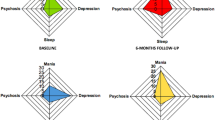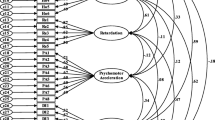Abstract
Current nosography classifies major psychoses as separate disorders, but their symptomatological presentation during illness episodes largely overlaps and diagnoses may change during a lifetime. Few analyses of major psychoses symptomatology have been performed so far because of the large number of subjects needed to obtain stable factors. The purpose of this study was, therefore, to identify the symptomatologic structure common to major psychoses based on lifetime symptoms. Two thousand and forty-one inpatients affected by schizophrenic (n=1008), bipolar (n=563), major depressive (n=352), delusional (n=108) and psychotic not otherwise specified disorder (n=210) were rated for lifetime symptoms using the Operational Criteria Checklist for Psychotic Illness (OPCRIT) and included in a factorial analysis. Four factors were obtained, the first consisted of excitement symptoms, the second comprised psychotic features (delusions and hallucinations), the third comprised depression and the fourth disorganization. When scored by the OPCRIT checklist, major psychoses symptomatology is composed of excitement, depressive, delusion and disorganization symptoms.
Similar content being viewed by others
Author information
Authors and Affiliations
Additional information
Received: 13 November 2000 / Accepted: 25 June 2001
Rights and permissions
About this article
Cite this article
Serretti, A., Rietschel, M., Lattuada, E. et al. Major psychoses symptomatology: factor analysis of 2241 psychotic subjects. European Archives of Psychiatry and Clinical Neurosciences 251, 193–198 (2001). https://doi.org/10.1007/s004060170040
Issue Date:
DOI: https://doi.org/10.1007/s004060170040




